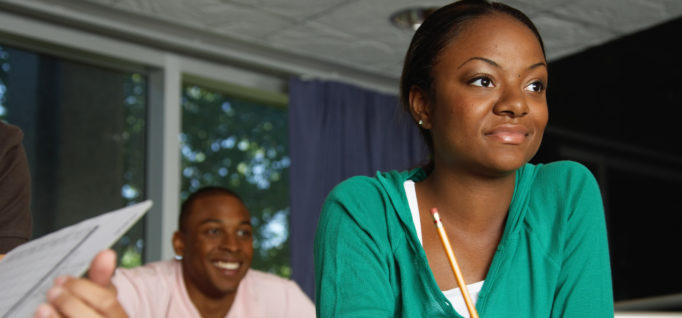Flexible Environments Engage Learners
By Kurt Shirkey
June 14, 2016
Salt Lake Community College has redesigned 20 classrooms to better facilitate a collaborative learning model.
The following article was originally published in the Community College Daily.
When most people think back to their college classes, they remember big lecture halls with a professor in the front of the class either writing on a chalkboard or lecturing from behind a lectern – or both.
Although many classes are still lecture-based, research conducted by the Community College Survey of Student Engagement indicates that the more actively engaged students are in their classes and course content, the more likely they are to achieve high marks. To provide a more engaging experience in the classroom, many of our professors at Salt Lake Community College (SLCC) implement “flipped” instruction. This consists of students learning course content outside of class so they can spend class time applying it to discussions, group projects or problem solving.
Lecture halls are not very conducive to flipped instruction, however. To better facilitate this collaborative learning model, the eLearning and classroom technology support departments proposed a series of alternative teaching and learning spaces called “flex classrooms.” Our idea was to redesign 20 classrooms throughout our campuses to include flexible furnishings, multiple displays and interactive technologies. These flex classrooms would support flipped instruction, expose students to new technologies and foster inclusivity, engagement and deeper learning.
Flex pilots
After the proposal for the project was accepted, the college allocated $1.3 million to make it happen before 2017. In fall 2014, we designed and built two pilot flex classrooms to test various design elements and technology. We took an old computer lab with white walls, a tile floor, a whiteboard and a projector and completely transformed it. We added carpet, accent paint, portable whiteboards and glass marker boards for group work, multiple projectors and flat-panel displays, enhanced wireless access points with wireless connections for all devices to the displays, and digital cabling and switching.
For furniture, we purchased mobile lecterns for professors and mobile tables and chairs for students. We wanted teachers and students to be able to move freely around the classroom, so it was important that the furniture was mobile so the classroom did not have a clearly defined “front” or “back” of the room.
Once completed, we asked instructors from the School of Business to teach classes in these rooms for a semester and provide their feedback on what worked, but most importantly what didn’t work in these classrooms.
The biggest technical takeaways from the pilot classroom design included:
-
Faculty members wanted the ability to send content from their own devices to every display in the room.
-
We needed to investigate a better way to wirelessly send content from students’ devices to their group displays.
-
Installing too many displays limited the effectiveness of the room because it seemed too crowded or too complicated to connect multiple devices.
Making tweaks
Taking this feedback into consideration, we refined our technology approach and built our first two official flex classrooms. We limited the number of displays to three or four per room and installed Epson BrightLink interactive projectors above the classroom’s whiteboards.
For improved connectivity, both instructors and students have wireless access to the interactive projectors to present content from their personal devices. They can wirelessly broadcast their own device content to any of the room’s multiple displays. Both teachers and students can annotate slides, webpages, documents and pictures using the interactive pens as annotation tools. They can then save the file and email it to group members or the entire class as notes.
These two flex classrooms have been used for a full semester, so we are revisiting the technical designs a second time and using the feedback to finalize some additional changes to replicate the design in the remaining flex classrooms.
We are in year two of the three-year project and are nearing completion of two additional flex classrooms. Construction for nine more flex classrooms this summer have been scheduled. The final seven rooms will start construction next year and should be completed by next summer.






